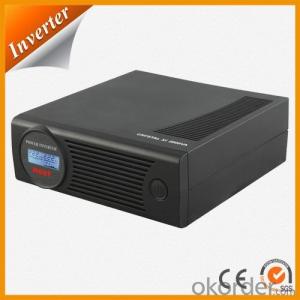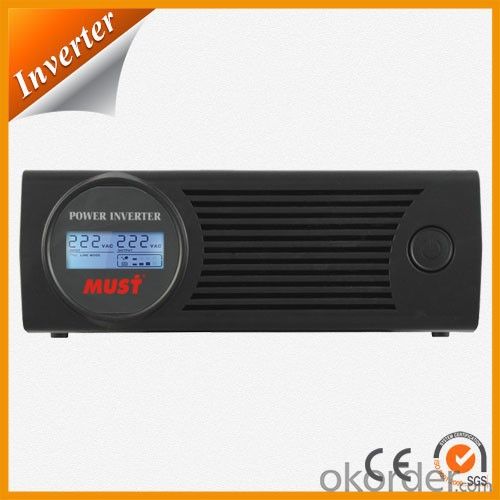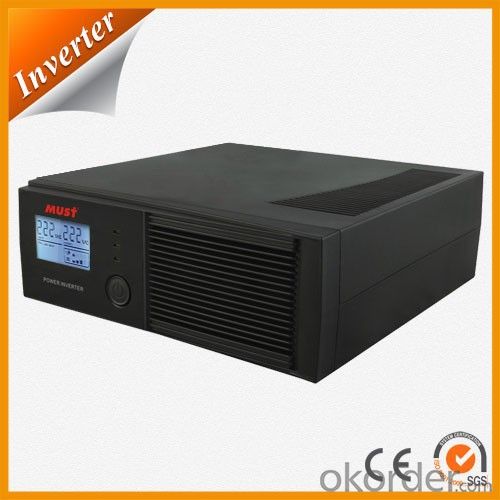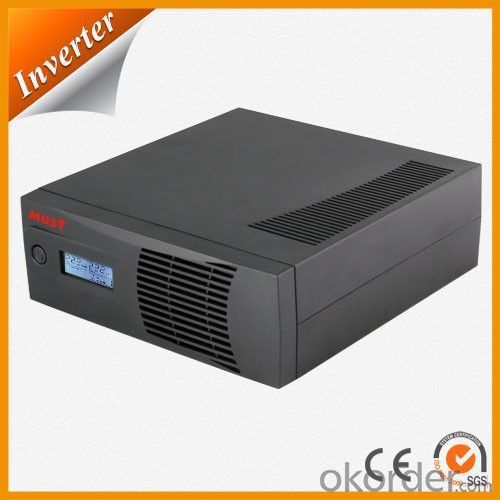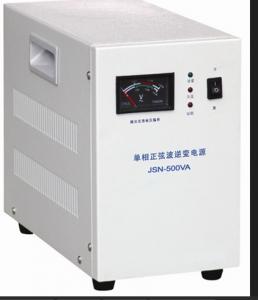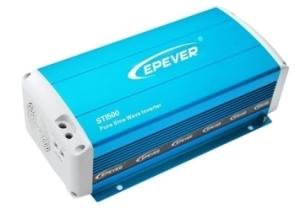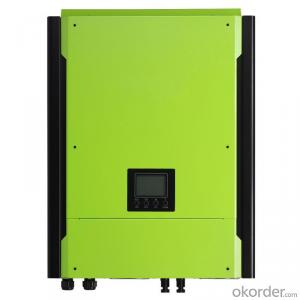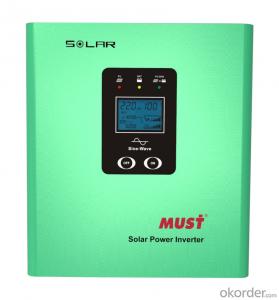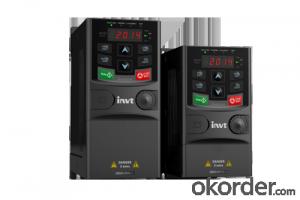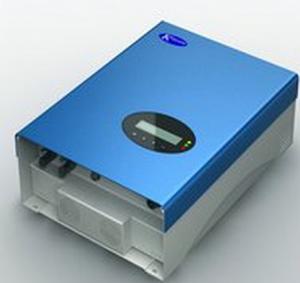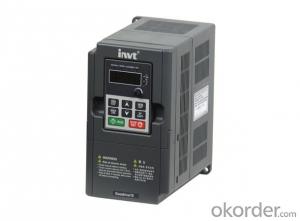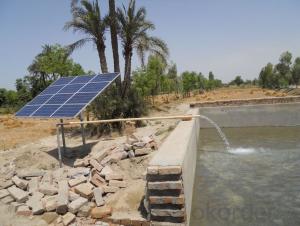Mini Solar Inverter CE Approved EP1000 with Competitive Price
- Loading Port:
- China main port
- Payment Terms:
- TT or LC
- Min Order Qty:
- 50 unit
- Supply Capability:
- 1000 unit/month
OKorder Service Pledge
OKorder Financial Service
You Might Also Like
Features:
Main for home and office Appliance such as TV,refrigerator,fan,lights,computer etc.
1.User selectable for accepting wider input voltage.
2.Rack Tower design, high Frequency, off mode charging.
3.Compact size for convenient use and storage.
4.Built-in from 8Amp super charger up to 100Ah battery.
5.Small scale and cost effective inverter for home appliances and office equipments
6.Three – steps Three – steps intelligent charging control to recharging time.
NEW Function:10A/20A charging current adjustable .
Four new panel for your reference
Front panel & Sockets
Inside Structure
Rated Capacity | 500VA/300W | 1000VA/600W | 2000VA/1200W |
Input | |||
Models | 120V Models | 230V Models | |
Nominal Voltage | 110V/115V/120V Selectable | 220V/230V/240V Selectable | |
Input Frequency | 47Hz ~ 65Hz, 50/60Hz Auto-Sensing | ||
Efficiency | 95%(Normal Mode) | ||
Noise Filtering | Full Time EMI/RFI Filtering | ||
Over Current Protection | By Re-Settable Over Current Protector | ||
Voltage Range | 90 - 145VAC Or 170-280VAC ( Narrow Range ) | ||
Surge Protection | 324 Joules | ||
Output | |||
Rated Power | 500va/300w | 1000VA/600W | 2000VA/12000W |
Output Voltage | 100V/110V/115V/120V Selectable | 220V/230V/240v selectable | |
Voltage Waveform | Modified Sine Wave | ||
Crest Factor | 3:01 | ||
Output Frequency (Synchronized-Mains) | Auto Select For 50/60Hz 47Hz ~ 55Hz For 50Hz Nominal; 56Hz ~ 65Hz For 60Hz Nominal | ||
Regulation(Battery Mode) | 10% -18% | ||
Transfer Time | 15ms Typical 50ms Max | ||
Protection | Over Load, Discharge, Overcharged | ||
Battery Type | Lead-Acid 12V 25Ah ~ 250Ah | ||
Voltage | 500VA/1000VA :DC12V ; 2000VA :DC24V | ||
Backup Time | Depend On Battery | ||
Charging Method | 3 Steps Super Charge Mode | ||
Charging Current | 10A-20A Adjustable Charge Current | ||
Protection | Over Current Protection Over Charging Voltage Protection (No More Than 15V) Deep Discharge, Overload Protection | ||
Communications & Management | |||
Control Panel(LCD Indicator) | Input & Output Voltage, Battery Capacity, | ||
Audible Alarm | Low Battery | Sounding Every 2 Seconds | |
Overload | Sounding Every 0.5 Second | ||
Fault | Continuously Sounding | ||
Environment And Safety | |||
Operating Environment | 0~40 Degrees Centigrade, 0 - 90% Non Condensing | ||
Transit/Storage | -15℃ To 55℃ (5℉ To 131℉) D39 | ||
Operating Altitude | 0 ~ 3000 Meters | ||
Audible Noise | ≦50dba | ||
Safety Markings | CE.FCC | ||
Quality Control System | ISO 9001 | ||
Physical | |||
Dimensions (H×D×W) | 355*130*230mm | ||
N.W/G.W(Kg) | 1.6/2 (Kg) | 2/2.3 (Kg) | 2.2/2.6 (Kg) |
Packing | 6pcs/Carton | ||
Warranty
provides a 1~3 year limited warranty (“Warranty”) against defects in materials and workmanship for its Uninterruptible power supply, Power inverter/chargers, Solar charge controllers, Battery Products (“Product”).
The term of this Warranty begins on the Product(s) initial purchase date, or the date of receipt of the Product(s) by the end user, whichever is later. This must be indicated on the invoice, bill of sale, and/or warranty registration card submitted to MUST-Solar. This Warranty applies to the original MUST-Solar Product purchaser, and is transferable only if the Product remains installed in the original use location.
FAQ
1. How do I decide which system is right for me ?
For protection from long outages, include a generator or solar panels in your Must solar system. Shorter outages can be handled by a battery-only system.
2. Where my system will be installed ?
Must solar systems are usually wall-mounted near a home's main electrical (circuit breaker) panel.
3. How do I install my system ?
A must solar backup inverter is connected to a home electric system , we will supply detailed installation manual and videos for our customers .
Images
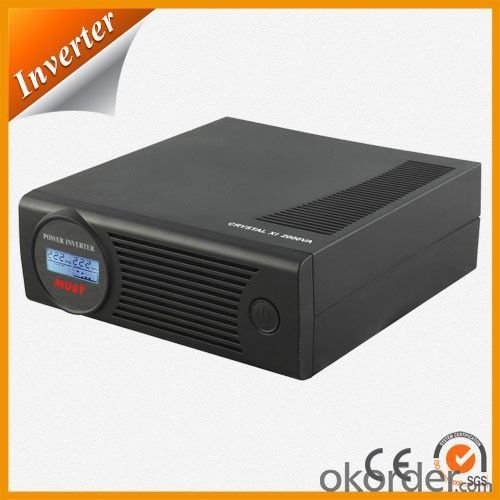
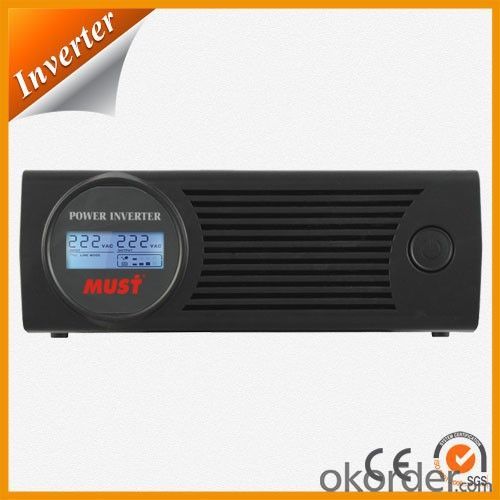
- Q: Can a solar inverter be used in conjunction with a backup generator?
- Yes, a solar inverter can be used in conjunction with a backup generator. In fact, this combination is often used in hybrid solar systems to provide continuous power supply even during times of low solar generation or power outages. The solar inverter manages the power flow from both the solar panels and the generator, ensuring a seamless transition between power sources and maximizing the utilization of renewable energy.
- Q: How does a solar inverter handle grid faults or disturbances?
- A solar inverter handles grid faults or disturbances by quickly detecting any changes in the grid voltage or frequency. When a fault or disturbance occurs, the inverter's protective features activate, causing it to disconnect from the grid momentarily. Once the fault or disturbance is resolved, the inverter automatically reconnects to the grid and resumes normal operation. This ensures the safety of the solar system and prevents any damage to the inverter or the grid.
- Q: Can a solar inverter be used for residential applications?
- Yes, a solar inverter can be used for residential applications. A solar inverter is an essential component of a residential solar energy system as it converts the direct current (DC) generated by solar panels into usable alternating current (AC) electricity that can power household appliances and be fed back into the grid.
- Q: What is the lifespan of the capacitors in a solar inverter?
- The lifespan of capacitors in a solar inverter can vary depending on several factors such as the quality of the capacitors, the operating conditions, and the overall design of the inverter. However, on average, high-quality capacitors in a well-designed solar inverter can have a lifespan of around 10 to 15 years. Regular maintenance and proper usage can help extend the lifespan of the capacitors in a solar inverter.
- Q: What certifications should I look for when choosing a solar inverter?
- When choosing a solar inverter, it is important to look for certifications such as IEC 62109 or UL 1741. These certifications ensure that the inverter meets necessary safety and performance standards. Additionally, certifications like ISO 9001 indicate that the manufacturer follows quality management systems.
- Q: Can a solar inverter be used with different AC voltages?
- No, a solar inverter cannot be used with different AC voltages. It is designed to convert the DC power generated by solar panels into a specific AC voltage that is compatible with the electrical grid. Using it with a different AC voltage could lead to inefficient operation or even damage the inverter.
- Q: How do you calculate the power loss in a solar inverter?
- To calculate the power loss in a solar inverter, you need to determine the difference between the input power and the output power. Subtracting the output power from the input power will give you the power loss.
- Q: How much maintenance is required for a solar inverter?
- Solar inverters typically require very little maintenance. They are designed to be reliable and durable, requiring minimal attention throughout their lifespan. Regular visual inspections to check for any debris or dust accumulation, as well as ensuring proper ventilation, are recommended. Additionally, monitoring the inverter's performance through software or online platforms can help identify any potential issues. However, in general, solar inverters are known for their low maintenance requirements, making them a reliable choice for renewable energy systems.
- Q: What is the maximum efficiency rating of a solar inverter?
- The maximum efficiency rating of a solar inverter can vary depending on the model and manufacturer, but typically it ranges from 95% to 98%.
- Q: Can a solar inverter be used with a wind turbine?
- Yes, a solar inverter can be used with a wind turbine. Both solar panels and wind turbines generate DC (Direct Current) power, which needs to be converted into AC (Alternating Current) power to be used in households or connected to the grid. A solar inverter can perform this conversion for both solar and wind power sources. However, it is important to note that there are specialized wind turbine inverters available that are specifically designed to optimize the performance and efficiency of wind turbines.
Send your message to us
Mini Solar Inverter CE Approved EP1000 with Competitive Price
- Loading Port:
- China main port
- Payment Terms:
- TT or LC
- Min Order Qty:
- 50 unit
- Supply Capability:
- 1000 unit/month
OKorder Service Pledge
OKorder Financial Service
Similar products
Hot products
Hot Searches
Related keywords
